Jamaican Fruits
What A Salad!
If you explore Jamaican fruits, you'll soon discover that we have many that are international staples - banana, pineapple, papaya (we call it paw-paw), various types of melons.
But there is a whole host of fruit in Jamaica that you might not come across in your every day runnings. These are the ones I'll tell you a little bit about on this page. Of course, I can only describe them in words and pictures - the taste and the smell are another matter entirely.
Jamaican Fruits
Mango
This is the queen of all Jamaican fruit, loved by all. Many varieties, boasting differences in taste, texture, appearance, scent and "hairiness". It's hard to eat a mango without a few hairs getting stuck in your teeth!
The frontrunners for favourite mango would have to be the East Indian and the Julie, but my personal favourite is the Bombay - just the right combination of tangy and sweet, not much hair to stick in your teeth.
Other popular varieties are Number 11, Green Skin, John Belly Full (a really big mango), Plummie, Robin, Tommy Atkins and the Common Mango.
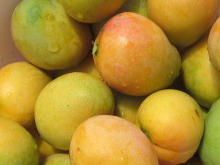
Many shopkeepers, particularly in the country areas, hate mango season because food sales tend to drop at this time. A traditional Jamaican folk song highlights this:
"Inna di height a di mango crop, when di fruit dem a ripe and drop, Wash yu pot, tun dem down, Mango Time".
This means you can wash your pots, turn them down, and not bother to cook during mango season.
The mango originated in India, and was brought to Jamaica in the late 18th century. The tree grows at sea level, up to elevations of about 4000 feet.
Mangoes which are allowed to ripen on the tree are much more flavourful than those picked green and sent abroad to ripen. So a mango in Jamaica is likely to taste a lot better than those sold in North American or European markets. You're bound to find a variety of these nutritious Jamaican fruits that you will love.
Otaheite Apple
I've yet to experience a more delectable fruit than a perfect otaheite (aka "apple" or "eati-oti"). Its delicate fragrance, red skin and snowy white flesh meet in your mouth for an incredible taste sensation.
YOU HAVE TO TRY THIS!
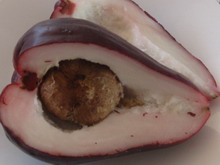
The otaheite (pronounced O-Tahiti) tree is a beautiful one -
well proportioned, classic triangle shape, shiny dark green leaves, decorated at times with deep pink flowers.
The young fruit grow in clusters along the trunk and branches. The tree was brought from Tahiti to Jamaica by Captain Bligh in 1793. It usually bears from February to April, and again in June and July.
Naseberry
Pronounced "neezeberry", this is quite an unusual looking fruit, with brown skin, brown flesh and small black seeds.
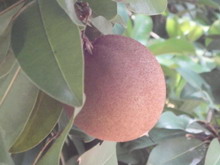
It is well loved for its extremely sweet taste and its striking aroma. The tree grows from sea level to 1200 feet. It is known as Sapodilla in other countries, and is native to the Caribbean. It is in season from March to May.
Starapple
Another of our distinctive Jamaican fruits, the starapple gets its name from the design seen in its flesh when the fruit is halved crosswise. This sweet, sometimes slightly stainy (starchy) fruit is usually eaten with a spoon. The smooth green or purple-black skin is not usually eaten.
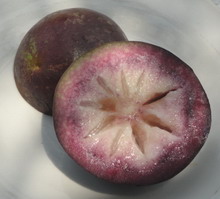
Starapples never fall from the tree, and are not always easy to pick. The tree is quite large, and sports two-toned leaves which are green on the top with a shiny brown underside.
The tree is native to Jamaica. The fruit is in season from November to March.
Tamarind
Tambrin (as we pronounce it here) in its natural state is one of the sourest fruits I have ever tasted. It grows in pods which turn brown and brittle when the fruit is ripe.
The flavour-packed flesh sticks to the casing which covers the small brown seeds. The flesh is sucked off if the fresh fruit is being eaten, or scraped off and mixed with sugar to be made into a drink, or a popular sweet called tamarind balls.
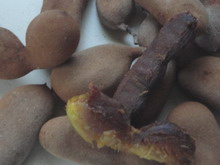
The term "tambrin season" is often used to indicate hard times, as when the tamarind is bearing (January to March), other Jamaican fruits tend to be scarce. The tree is believed to have come from Africa in the 17th century. The itching associated with chicken pox can be relieved by soaking in a bath drawn with tamarind leaves.
Guava
With many Jamaican fruits, you smell them before you see them. The ripe guava has a very striking scent - not a bad smell, just a strong one. The type that turns corners and follows you around.
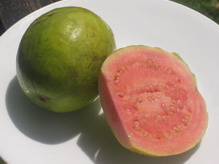
This fruit is the delicious main ingredient of guava jelly and jam, and a confection knows as guava cheese.
As the guava ripens, it turns from green to yellow. All parts of the guava can be eaten - the skin, the outer yellow flesh, the inner pink flesh littered with hundreds of tiny edible seeds.
The tree does not grow very big (around 20 feet), and has a smooth, beige bark. The fruit is packed with Vitamin C.
Ortanique
This citrus fruit was developed in Jamaica, a cross between an orange and a tangerine. The name is derived from the words "orange, tangerine and unique".
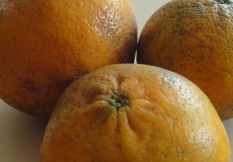
It is flatter and juicier than a regular orange, with a thicker skin which makes it easier to peel (though not as easy as a tangerine). It originated in the parish of Manchester, which is known for citrus production.
June Plum
It's really a "Jew Plum", but no one calls it that any more. My grandma used to scold me "do you see it bearing in June?" The june plum grows on a tree with a reddish, gum-producing bark.
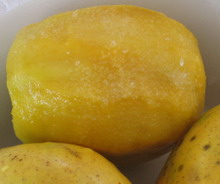
We often don't wait for this fruit to ripen. Children will happily eat the green fruit, cracking them open by throwing them against a hard surface to reveal crispy white flesh beneath.
The ripe fruit are juicy orange-yellow, with a sweet and sour combo that's amazing to smell and taste.
The extra-terrestrial looking seed is cream coloured, with corky spikes sticking out in every direction. And we still manage to suck the seed clean! The june plum is used to make juices and chutneys.
Sugar Cane
Technically a grass, the sugar cane is the stem from which sugar and rum are made. There is a thriving local industry for the unprocessed cane, which is peeled, cut up, and sold in small bags. You chew it up to remove the juice, then spit out the fibre, which we call the "trash".
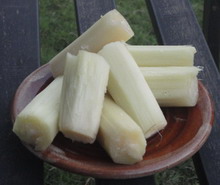
Sugar cane is grown on the island's plains. It is grown on large plantations, and also by smaller farmers who sell to the sugar factories.
It was brought to the Caribbean by Columbus, spreading through most of the islands, including Jamaica. The sugar industry was the driving force behind the institution of slavery in Jamaica.
Sweet Sop
Some Jamaican fruits require patience, but are well worth the effort. Eating a sweet sop takes a fair bit of navigation to remove the sweet white pulp from the multitude of black seeds inside every fruit.
The appearance of the fruit is what Jamaicans would describe as "bumpy-bumpy" - it has many grooves marking out distinct segments on its skin. When the sweet sop is ripe its skin remains green, but the fruit becomes soft and is easily split open. It bears from April to July, and at odd times throughout the year.
Sour Sop
A relative of the sweet sop, but bigger, with a prickly skin. The flesh is similar - white and pulpy, but a bit coarser than that of the sweet sop, and not really sour. Sour sop is usually made into a drink, with milk or lime juice. The leaves are used to make a tea to treat hypertension, fever and colds.
Garden Cherries
Small, often excruciatingly sour, garden cherries grow on small shrubby trees which give easy access to small children. They have a corky seed that is often swallowed by children despite dire warnings from their mothers.
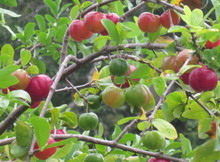
They are loaded with Vitamin C, and can be blended, strained and sweetened to make a wonderful juice.
Guinep
Don't get guinep juice on your clothes or you'll have a stain for life! Sold in bunches with stems tied together, the summer months wouldn't be the same without the sight of guineps everywhere.
This is a fruit for the persistent. Often a bit stainy, it can take forever to suck the pinkish flesh from the seeds of these small green Jamaican fruits.
Small children are usually admonished to crack the seed before eating, to avoid it slipping down whole. This advice is usually ignored, as it's no fun to suck the seed unless it's whole.
Plum
This term covers many species of small Jamaican fruits, with one thing in common - children can't resist them! We have coolie plums, hog plums, or just plain "plums".
I could go on and on, as the array of Jamaican fruits is really a wide one. There is the huge jackfruit (huge smell!), the less common roseapple and custard apple, the cherrimina. The national fruit is the Ackee, but we don't really eat it as a fruit, as it has to be cooked.
Let me leave you with a picture of a mangerine, and also a fruit whose name describes it perfectly, the Stinking Toe (Tinkin Toe)!
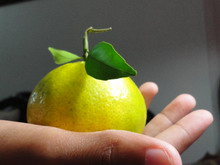
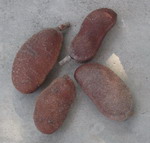
Return from Jamaican Fruits to Real Jamaica Vacations




